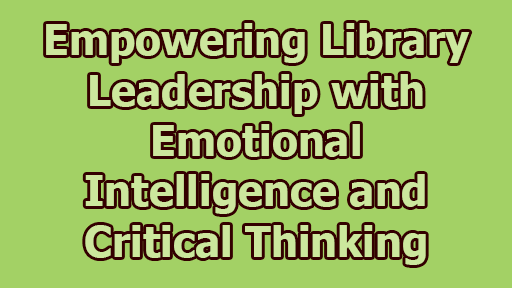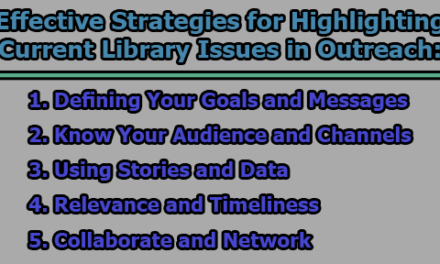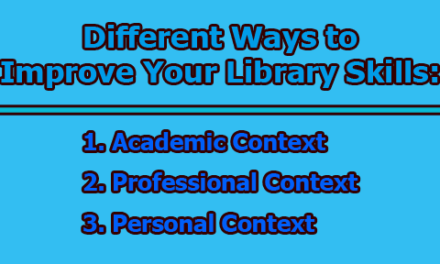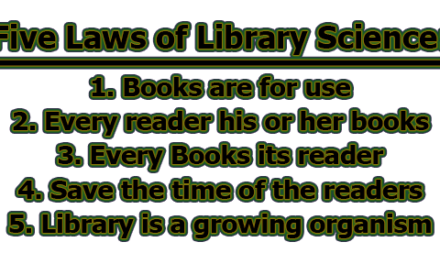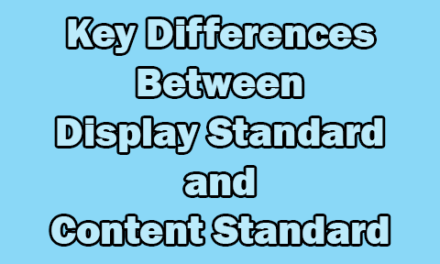Empowering Library Leadership with Emotional Intelligence and Critical Thinking:
In the rapidly evolving landscape of library leadership, the need for a dynamic set of skills has never been more crucial. Libraries once considered bastions of static information, have transformed into vibrant hubs of knowledge, community engagement, and innovation. To navigate this ever-changing terrain successfully, library leaders must possess a unique blend of qualities that encompass emotional intelligence (EI) and critical thinking (CT). This symbiotic relationship between EI and CT empowers leaders to not only connect with their teams and communities on a deeper level but also to make informed, forward-thinking decisions. In this article, we will explore; empowering library leadership with emotional intelligence and critical thinking.
1. The Role of Emotional Intelligence in Library Leadership:
1.1 Defining Emotional Intelligence (EI): Emotional intelligence, coined by psychologists Peter Salovey and John Mayer and popularized by Daniel Goleman, encompasses a set of skills that enable individuals to recognize, understand, manage, and utilize emotions—both their own and those of others—in constructive ways. EI is a multifaceted concept consisting of several key components:
- Self-awareness: This foundational component involves recognizing and understanding one’s own emotions, strengths, weaknesses, values, and how one’s emotional state influences decisions and actions.
- Self-regulation: Self-regulation pertains to the ability to manage and control one’s emotional responses, especially in stressful or challenging situations. Leaders with strong self-regulation can maintain composure and make rational, well-informed decisions under pressure.
- Empathy: Empathy is the capacity to understand and relate to the emotions and perspectives of others. Library leaders with high empathy can connect with their team members, patrons, and stakeholders on a deeper level, fostering trust and cooperation.
- Motivation: Motivated leaders are driven by intrinsic factors such as passion, commitment, and a sense of purpose. They inspire and energize their teams with their enthusiasm, determination, and resilience in the face of adversity.
- Social skills: Social skills encompass a range of interpersonal abilities, including active listening, effective communication, conflict resolution, and collaboration. Leaders with strong social skills excel at building positive relationships, navigating conflicts, and communicating their vision effectively.
1.2 The Relevance of EI in Library Leadership: In the context of libraries, where human interactions and relationships are at the core of daily operations, emotional intelligence assumes immense significance. Here’s a closer look at why EI is indispensable for library leaders:
- Enhancing Team Dynamics: Library leaders with high EI are better equipped to understand the emotions, motivations, and needs of their team members. This understanding allows them to create a positive and supportive work environment, leading to improved collaboration, staff satisfaction, and productivity.
- Effective Communication: Libraries serve diverse communities, and library leaders frequently interact with a wide range of stakeholders, from library staff to patrons, donors, and community partners. EI enables leaders to tailor their communication style to the unique needs and expectations of different audiences, making interactions more meaningful and persuasive.
- Conflict Resolution: Conflicts can arise in any workplace, including libraries. Leaders with strong EI can navigate conflicts with empathy and diplomacy, finding solutions that satisfy all parties involved and preserving the harmony of the work environment.
- Decision-Making: Library leaders regularly make decisions that have a significant impact on their institutions and the communities they serve. EI enables leaders to make more informed and balanced decisions by considering both the emotional and rational aspects of a situation, leading to more thoughtful and well-received choices.
- Adaptability: Libraries are in a state of constant evolution, responding to technological advancements, changing user expectations, and evolving societal needs. Leaders with high EI are more adaptable and open to change, facilitating the library’s ability to innovate, stay relevant, and meet the evolving needs of their communities.
1.3 Assessing and Cultivating EI in Library Leadership: Assessing and developing emotional intelligence is an ongoing and highly personalized journey. Library leaders can take several steps to enhance their EI:
- Self-reflection: Leaders can begin by regularly reflecting on their emotional responses to various situations and considering how these emotions influence their actions and decisions. Journaling can be a valuable tool for this purpose.
- Feedback: Seeking feedback from colleagues, staff, mentors, and trusted advisors can provide valuable insights into one’s strengths and areas for improvement in emotional intelligence.
- Training and Development: Attend workshops, seminars, or courses that focus on emotional intelligence. These programs can provide leaders with practical tools and techniques for enhancing EI.
- Mindfulness and Meditation: Practices such as mindfulness and meditation can help leaders become more self-aware and improve their ability to self-regulate emotions. Mindfulness exercises can be integrated into daily routines to promote emotional balance.
- Coaching and Mentorship: Consider working with an executive coach or mentor who specializes in emotional intelligence. These individuals can provide guidance, support, and tailored strategies for developing and applying EI in leadership contexts.
2. The Significance of Critical Thinking in Library Leadership:
2.1 Defining Critical Thinking: Critical thinking is a cognitive process characterized by the systematic analysis, evaluation, interpretation, and synthesis of information, ideas, situations, or problems. It involves the ability to think logically, make reasoned judgments, and consider multiple perspectives before making decisions or taking action. Critical thinking comprises several key attributes:
- Analysis: The skill of dissecting complex issues into their constituent parts and examining each element independently and in relation to the whole.
- Interpretation: The capacity to understand and explain the meaning or significance of information, data, or situations.
- Evaluation: The ability to assess the quality, validity, and reliability of information, arguments, or solutions.
- Inference: Drawing logical conclusions and making predictions based on available information and evidence.
- Explanation: Clearly and concisely articulating one’s thought processes and rationale for a particular decision or action.
- Problem-solving: Applying critical thinking skills to address challenges, find solutions, and make informed decisions.
2.2 The Relevance of Critical Thinking in Library Leadership: Critical thinking is of paramount importance in library leadership for several compelling reasons:
- Decision-Making: Library leaders frequently face complex decisions, ranging from resource allocation to strategic planning. Critical thinking equips leaders with the ability to carefully analyze and evaluate options, consider potential consequences, and make well-informed choices.
- Innovation: In an era of rapid technological advancement and shifting user expectations, libraries must continually innovate to remain relevant. Critical thinking encourages creative problem-solving and the exploration of new ideas, which are essential for driving innovation within library services and operations.
- Adaptability: Libraries operate in a dynamic environment where change is constant. Leaders with strong critical thinking skills are better equipped to adapt to evolving circumstances, adjust strategies, and guide their teams through transitions effectively.
- Evidence-Based Decision-Making: Critical thinking promotes evidence-based decision-making. Leaders who rely on data, research, and evidence rather than intuition or anecdotal information are more likely to make decisions that align with the library’s mission and goals.
- Effective Communication: Critical thinking enhances leaders’ ability to communicate clearly and persuasively. Leaders who can present well-reasoned arguments and explanations are more likely to gain the support of stakeholders and colleagues.
2.3 Developing Critical Thinking Skills in Library Leadership: To harness the power of critical thinking, library leaders can employ several strategies:
- Training and Education: Library leaders can engage in training and workshops focused on critical thinking. These programs provide tools and methodologies for developing critical thinking skills.
- Continuous Learning: Encourage a culture of continuous learning and intellectual curiosity within the library. This includes reading widely, staying informed about emerging trends, and engaging in professional development opportunities.
- Problem-Solving Exercises: Encourage leaders and staff to participate in problem-solving exercises and scenario-based discussions. These activities promote the practical application of critical thinking skills.
- Mentoring: Pair emerging leaders with experienced mentors who can provide guidance and share their own experiences with critical thinking and decision-making.
- Encourage Questioning: Foster an environment where questioning and the exploration of different viewpoints are encouraged. This not only cultivates critical thinking but also promotes a culture of open dialogue.
3. The Intersection of Emotional Intelligence and Critical Thinking in Leadership:
3.1 The Synergy Between EI and CT:
- Enhanced Decision-Making: The synergy between EI and CT empowers leaders to make decisions that are not only logically sound but also considerate of the emotional impact on individuals and teams. Leaders can weigh the rational aspects of a choice alongside the emotional consequences, resulting in more well-rounded decisions.
- Effective Communication: Leaders with high EI and CT are adept at both articulating their thoughts logically and empathetically and understanding the emotional nuances in others’ communication. This dual capacity promotes effective, empathetic, and persuasive communication.
- Conflict Resolution: Conflict is inevitable in leadership roles. EI enables leaders to approach conflicts with empathy and emotional regulation, while CT equips them with analytical tools to dissect the issue and find constructive solutions.
- Team Collaboration: The combination of EI and CT fosters a collaborative environment where team members are not only encouraged to think critically but also feel heard, understood, and valued. This synergy bolsters team dynamics and productivity.
- Innovation: Effective leaders need to inspire creativity and innovation. EI encourages an open and supportive atmosphere where team members feel comfortable expressing their ideas, while CT enables leaders to evaluate those ideas critically, leading to innovative solutions.
- Adaptability: Library leaders operate in a rapidly evolving landscape. EI equips leaders with adaptability, resilience, and the capacity to navigate change, while CT helps them analyze emerging trends and make data-informed decisions.
3.2 Practical Application: Balancing Emotions and Logic: The practical application of the intersection between EI and CT involves balancing emotions and logic in leadership roles. Here are some key considerations:
- Self-awareness: Leaders should be aware of their emotional responses to situations and how those emotions may influence their critical thinking processes.
- Empathy: Leaders can use empathy to understand and connect with their team members, recognizing that different individuals may have different emotional needs and responses.
- Conflict Resolution: When addressing conflicts, leaders can use their EI to create a safe space for open dialogue and their CT to analyze the root causes and develop solutions.
- Effective Decision-Making: When making decisions, leaders can employ CT to weigh evidence and analyze options, while leveraging their EI to consider the emotional impact on stakeholders.
4. The Ripple Effect: Benefits to Libraries and Communities:
4.1 Enhanced Library Services:
- Community-Centered Approach: Leaders with high EI understand the unique needs and preferences of their community members. This understanding allows libraries to tailor services, programs, and collections to better cater to the community’s diverse requirements.
- Increased Patron Satisfaction: By responding to community needs effectively, libraries led by emotionally intelligent leaders experience increased patron satisfaction and engagement.
4.2 Innovation and Adaptation:
- Fostering Creativity: Leaders who promote CT inspire innovation within their libraries. Staff members are encouraged to think critically, challenge the status quo, and propose innovative solutions to emerging challenges.
- Dynamic Service Development: The result is a library that remains flexible and dynamic, continuously adapting to the evolving needs of its community.
4.3 Effective Resource Allocation:
- Data-Informed Decisions: CT-driven library leaders base resource allocation decisions on data and evidence, ensuring that budgets are allocated where they are needed most. This may involve prioritizing digitization efforts, collection development, or community outreach programs.
- Optimized Resource Utilization: Libraries led by CT-oriented leaders make the most of their resources, ensuring that investments align with strategic priorities.
4.4 Community Engagement:
- Open Dialogue: Leaders with high EI create an environment where community members feel heard and valued. This leads to open and constructive dialogues about library services and programs, enabling libraries to better meet community needs.
- Enhanced Community Involvement: Engaged community members often become library advocates, actively participating in library programs and advocating for continued support.
4.5 Staff Morale and Development:
- Positive Work Environment: EI-focused leaders create a positive work environment where staff feel supported, understood, and motivated to excel in their roles.
- Professional Growth: Libraries led by emotionally intelligent leaders often prioritize staff development, offering opportunities for learning and advancement.
4.6 Conflict Resolution:
- Harmonious Relationships: Leaders skilled in EI effectively resolve conflicts within the library, promoting harmonious relationships among staff, patrons, and stakeholders.
- Positive Work Culture: A culture of trust and respect emerges, making the library an enjoyable place to work and visit.
4.7 Community Empowerment:
- Skills Transfer: Libraries led by CT-oriented leaders empower their communities with critical thinking skills. Workshops, educational programs, and resources provided by libraries can help community members improve their problem-solving abilities and decision-making.
- Lifelong Learning: Libraries become hubs for lifelong learning, fostering the intellectual growth and empowerment of their community members.
4.8 Cultural Relevance:
- Adaptation to Change: EI and CT skills enable library leaders to adapt to rapidly changing demographics, technological advancements, and cultural shifts. This adaptability ensures that libraries remain culturally relevant and responsive.
- Diverse Outreach: Libraries effectively reach and serve diverse populations, including minority and underserved communities.
4.9 Long-Term Sustainability:
- Strategic Planning: Library leaders with strong CT skills excel in long-term strategic planning. They anticipate challenges, identify opportunities, and develop sustainable strategies that ensure the library remains viable and resilient.
- Resource Allocation for Sustainability: Budgets are allocated strategically to support long-term goals, ensuring the library’s continued relevance.
4.10 Positive Image and Support:
- Community Advocacy: Libraries led by emotionally intelligent leaders often enjoy strong community support and advocacy. This support can translate into increased funding, resources, and recognition.
- Positive Public Perception: Libraries become viewed as essential community assets, leading to sustained community backing.
4.11 Inclusivity and Equity:
- Equitable Access: Library leaders with high EI promote inclusivity and equity by understanding the emotional and cultural needs of diverse community members. They work to ensure that library services and programs are accessible and relevant to all.
- Culturally Competent Services: Libraries actively work toward providing culturally sensitive and equitable services, fostering a sense of belonging for all community members.
4.12 Community Resilience:
- Empathy in Times of Crisis: In times of crisis or disaster, emotionally intelligent leaders can offer support, empathy, and resources to community members. Libraries become integral in supporting community resilience and recovery efforts.
- Community Hub: Libraries emerge as community hubs where individuals can find support, information, and resources during challenging times.
In conclusion, as libraries continue to adapt to the ever-changing needs of their communities, library leaders must evolve as well. Emotional intelligence and critical thinking are not just buzzwords but essential tools for effective library leadership. By cultivating these skills, library leaders can navigate challenges, inspire their teams, and lead their institutions into a future where libraries remain vital hubs of knowledge and community engagement.
Incorporating emotional intelligence and critical thinking into library leadership practices not only benefits the leaders themselves but also ripples outward, enriching the library’s impact on the community it serves. Through self-awareness, empathy, analytical thinking, and innovative problem-solving, library leaders can empower their teams and ensure that libraries continue to thrive in the 21st century.
References:
- Bradberry, T., & Greaves, J. (2009). Emotional Intelligence 2.0. TalentSmart.
- Brackett, M. A., & Katulak, N. A. (2007). Emotional Intelligence in the Classroom: Skill-Based Training for Teachers and Students. In J. Ciarrochi, J. R. Forgas, & J. D. Mayer (Eds.), Emotional Intelligence in Everyday Life (pp. 255-272). Psychology Press.
- Ennis, R. H. (1987). A Taxonomy of Critical Thinking Dispositions and Abilities. In J. Baron & R. J. Sternberg (Eds.), Teaching Thinking Skills: Theory and Practice (pp. 9-26). Freeman.
- Facione, P. A. (1990). Critical Thinking: A Statement of Expert Consensus for Purposes of Educational Assessment and Instruction. Research Findings and Recommendations. The American Philosophical Association.
- Goleman, D. (1995). Emotional Intelligence: Why It Can Matter More Than IQ. Bantam Books.
- Goleman, D. (1998). Working with Emotional Intelligence. Bantam Books.
- Halpern, D. F. (2014). Thought and Knowledge: An Introduction to Critical Thinking. Psychology Press.
- Nosich, G. M. (2012). Learning to Think Things Through: A Guide to Critical Thinking Across the Curriculum. Pearson.
- Paul, R., & Elder, L. (2006). Critical Thinking: The Nature of Critical and Creative Thought. Journal of Developmental Education, 30(2), 34-35.
- Salovey, P., & Mayer, J. D. (1990). Emotional Intelligence. Imagination, Cognition, and Personality, 9(3), 185-211.

Library Lecturer at Nurul Amin Degree College

